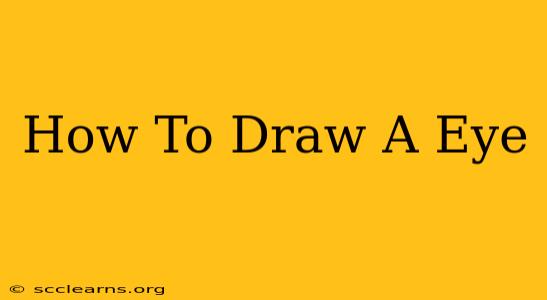Drawing a realistic eye can seem daunting, but with the right techniques and a little practice, you can master this fundamental skill. This guide breaks down the process into manageable steps, perfect for beginners and experienced artists alike. We'll cover everything from basic shapes to adding fine details, helping you create captivating and lifelike eyes.
Understanding the Anatomy of an Eye
Before you start sketching, it's helpful to understand the basic anatomy of an eye. This will help you accurately represent its form and structure. Key elements include:
- The Iris: The colored part of the eye. Its shape and color are crucial in defining the overall look.
- The Pupil: The black circle in the center of the iris, responsible for controlling the amount of light entering the eye. Its size varies depending on light conditions.
- The Sclera: The white part of the eye. Note that it's not perfectly white; it often has subtle shadows and variations in tone.
- The Highlights: Small, bright spots that reflect light, adding realism and depth to the eye.
- The Eyelashes: These add character and detail, and should be drawn carefully and individually.
Step-by-Step Guide to Drawing an Eye
Let's get started! Follow these steps to draw a realistic eye:
Step 1: Basic Shapes
Begin by sketching a basic circle for the iris. Then, add a smaller circle inside for the pupil. Finally, outline the general shape of the eye, incorporating the sclera. Don't worry about perfection at this stage; these are just guides.
Step 2: Defining the Iris
Add details to the iris. Use subtle variations in tone and shading to create texture and depth. Observe how the iris is not a uniform color; there are usually darker areas near the pupil and lighter areas towards the edge. You can create a more realistic iris by adding radial lines emanating from the pupil.
Step 3: Adding the Pupil and Highlights
The pupil should be a solid black, but remember to leave small areas of reflected light for added realism. These highlights are crucial for creating the illusion of a three-dimensional sphere. These can be small, bright white dots.
Step 4: Shading and Depth
Now, start shading the eye. Observe how light and shadow affect the different parts of the eye. The sclera will usually have a subtle shadow near the iris, adding depth and definition. Use soft gradations between light and dark areas to create a smooth, natural look. Don't be afraid to experiment with different shading techniques.
Step 5: Drawing the Eyelashes
Eyelashes are a crucial element of a realistic eye. Don't just draw a simple line; instead, draw individual lashes. Pay attention to the direction of their growth and how they curve. Consider the density and length of the lashes for a natural look. Remember that eyelashes are not uniformly thick, the base of the lash is thicker, tapering towards the tip.
Step 6: Refining and Detailing
Review your work and refine the details. Are the proportions correct? Do the shadows and highlights look natural? Continue to adjust your work until you are happy with the result. Adding subtle wrinkles or lines near the eye can further enhance its realism.
Tips for Success
- Use References: Use photographs or real-life models as references. Observing real eyes will greatly improve your understanding of their structure and nuances.
- Practice Regularly: The more you practice, the better you will become. Don't get discouraged if your early attempts aren't perfect.
- Experiment with Different Mediums: Try drawing with pencils, charcoal, or even digital painting software. Each medium offers different possibilities.
- Focus on Light and Shadow: Mastering light and shadow is key to drawing realistic eyes. Pay close attention to how light interacts with the different parts of the eye.
Drawing a realistic eye takes patience and practice, but the results are incredibly rewarding. With dedication and attention to detail, you'll soon be able to create captivating and lifelike eyes that add depth and realism to your artwork. So grab your pencils and start practicing!

